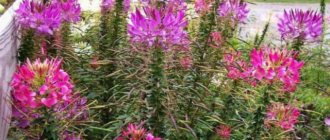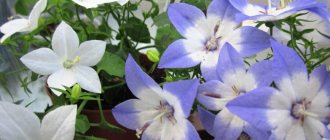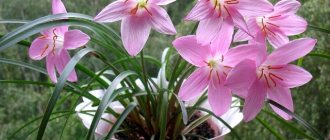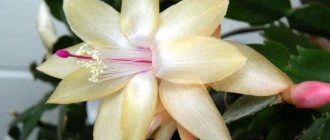The iris flower is perfect for growing not only in the garden, but also at home. In Greek, its name means rainbow. Irises are often called garden orchids for their beautiful large flowers of heavenly or purple color. Large-sized varieties have been bred through selection, used for planting in gardens, parks, and flower beds.
Many people prefer to grow these beautiful flowers at home on windowsills, as they can bloom as early as the end of February. Dwarf varieties were specially bred for growing in indoor flower beds. Having planted these flowers on your windowsill, at the end of February you can already admire the blooming of irises.
Irises of dwarf varieties do not take up much space; they reach a height of 10–20 cm. The color of the flowers is purple or blue. White specks can often be seen on the petals. Each plant produces several annual flower stalks. The flowers are usually solitary, but can sometimes appear in small inflorescences. In order for plants to bloom at the end of winter, they need to be planted in the fall.
Description
Important! The walking iris is characterized by lanceolate, dark green leaves with a length varying from 30 to 160 cm and a width from 1 to 4 cm (depending on the species).
The flower arrow, with its flat shape, visually resembles one of the leaves, but with thickening along the longitudinal axis.
At the end of the arrow there are rather large pale milky flowers with a diameter of 5-10 cm. The lifespan of each of them is no more than a day; over time, a new plant (baby) is formed in place of the withered one. Under its weight, the peduncle bends to the ground, and the baby takes root not far from the mother specimen. Thanks to this method of propagation, neomarica received the name “walking iris.”
This is what the plant looks like in the photo:
The following is a video about the flowering of neomarica:
Main types
Slender neomarica (Neomarica gracilis)
This herbaceous plant is quite large in size. Collected in a fan, the leathery sword-shaped leaves are colored green. Their length varies between 40–60 centimeters, and their width is 4–5 centimeters. The opening of flowers on peduncles occurs gradually. The flower stalks themselves bear up to 10 flowers, with a diameter of 6 to 10 centimeters. The flower fades a day after opening. So, in the morning it begins to open, in the daytime it reaches full disclosure, and in the evening it fades.
Planting and propagating indoor plants
You can get a new plant by planting baby shoots or sowing seed material. The baby formed at the site of the wilted flower is rooted in another container, with a layer of drainage laid out at the bottom.
- First, the shoot, which has not yet had time to take root, is fixed with a suitable object to the substrate and lightly sprinkled.
- After 2-3 weeks, the young plant takes root and begins to form leaves. At this time, it is carefully separated from the adult specimen, after which the peduncle itself is removed.
Attention! Neomarica obtained from a child begins to bloom 2 years after planting.
When replanting, it is permissible to separate overgrown bushes with several leaf rosettes.
- When removing the mother specimen from the pot, its root system is cut with a sharp knife so that each segment has at least 3 growth points.
- After this, all sections are treated with crushed activated carbon tablets for the purpose of disinfection.
- Each part is placed in a separate pot with a drainage system and a suitable soil mixture.
The seed propagation method is considered ineffective and difficult: only 50% of the planting material germinates.
- Seeds are sown in containers filled with peat-sand or light fertile substrate.
- The containers are covered with polyethylene or glass, with daily ventilation and moistening of the soil as it dries.
- The emergence of seedlings is observed after 2-3 weeks; after the formation of 2-3 leaves, they are picked, planted in separate pots.
Reference. Young plants need to be replanted annually, adults - once every 2-3 years.
There are several options for soil mixtures that are optimal for growing neomarica:
- peat mixture + coconut fiber (3/1);
- turf soil + agroperlite + crushed pine bark (3/1/1);
- peat mixture + leaf soil + agroperlite (1/2/1).
When preparing the soil mixture, it is not recommended to use humus, compost or vermicompost, since these components are unfavorable for the flowering of the walking iris.
Recommendations for forcing irises at home
- To force irises at home, take ordinary bearded purple irises, which bloom in late May - early June (at the same time as lilacs).
- At the end of June, plant (for growing) apical annual shoots with a fan of leaves in a garden bed or vegetable garden. Shorten the leaves to 10-15 cm. These plantings remain for the next year.
- In the spring and summer of next year, provide good care to the plants so that as many leaves as possible grow in the fan.
- In September-October, transplant two-year-old bushes into boxes, vessels, flower pots and leave them in open ground, but do not forget to water them. Select plants that have formed 7 or more leaves in a fan. In early November, bring the irises into the basement or other frost-free room (4-6°C).
- During storage, do not forget to water the plantings and do not let the soil dry out.
- Carry out forcing at the beginning of February, i.e. transfer the plants from the storage place to a warm, bright room with an average room temperature.
- The irises will bloom in early March.
| Tweet |
Conditions for growth and flowering
After acquisition, the plant is quarantined, and after about 3 weeks the pot is installed in a permanent place.
Temperature
The temperature of the flower in winter and summer should be different:
- In spring , at the beginning of the growing season, the room temperature should vary from +22 to +25 °C.
- On hot days, frequent spraying and bathing of the plant in the shower is necessary. Also at this time, it is recommended to take the pot out onto an unglazed balcony or into the garden.
- From the beginning of September , the temperature is gradually reduced by installing neomarika on a cool windowsill.
- From the end of November to February, the plant is taken out into an unheated room or onto a glassed-in loggia with a temperature of +8-12 °C.
Important! During the cold period, the flower needs protection from drafts and hypothermia.
In rooms with temperatures below recommended values, pots with plants are placed in sand or dry sawdust. Provided that wintering takes place in a warm room, the walking iris often blooms already in January.
However, the absence of a change of seasons negatively affects the condition of the plant and provokes its rapid depletion. To avoid this, it is necessary that the rest period be at least 2 months.
Lighting
For full growth, the flower needs bright and at the same time diffused lighting.
- In winter, western and southern windows will be a suitable place for it.
- In summer , from approximately 12:00 to 15:00, it is necessary to organize shading in order to protect the plant from direct infrared rays.
Watering
The neomarika watering regime depends on the time of year and indoor climate conditions:
- Early spring - the substrate is moistened regularly, but at the same time allowed to dry out by about ½ volume.
- Late spring, summer - the frequency and abundance of watering is increased, while allowing the top layer of soil to dry to a depth of 3 cm.
- Autumn - the frequency of watering is gradually reduced, drying the soil by ½ volume.
- Winter - the frequency of watering is reduced to a minimum, in this case the soil has time to dry out almost completely.
Attention! The humidity level in the room with the flower must correspond to the temperature, so in the summer a tray with water is placed under the pot and sprayed daily.
Top dressing
Since in nature the walking iris grows on poor soils, when grown in a pot it does not need intensive fertilizing. It is optimal to apply fertilizers from May to June with a frequency of 1-2 times a month. It is recommended to use formulations intended for orchids as fertilizers.
IRISES NEED GOOD CARE AFTER PLANTING IN OPEN GROUND
All irises (except Japanese) are quite drought-resistant. They accumulate moisture in the roots and therefore can do without it for a long time. But the soil around them should always be moist and loose. During the flowering period, water more often. It is recommended to water in the evening, making sure that drops of water do not fall on the flowers and leaves.
Irises are fed three times per season: in the spring, the plants are given nitrogen nutrition (urea solution or infusion of cow dung in a ratio of 1:10). In summer they give nitrogen-potassium fertilizers, and in autumn - potassium-phosphorus fertilizers.
After flowering ends, all dried leaves and flowers are carefully trimmed. Bearded miniature and medium-sized ones, as well as Siberian irises, do not cover for the winter. The rest are mulched with dry leaves and covered with spruce branches.
Pest protection
Neomarica is characterized by resistance to various diseases and pest attacks. However, improper care can lead to flower damage in the following ways:
- fungal diseases;
- aphids;
- spider mite.
To eliminate the problem that has arisen, the perennial is treated with a chemical preparation, and all agrotechnical rules are strictly observed during the care process.
Neomarica is a relatively unpretentious plant: in suitable growing conditions it will delight with its magnificent flowering for many years.
What is "forcing"?
There is general information about what forcing is that all beginning gardeners need to know. Plants in the temperate zone are dormant in winter at low temperatures. But among them there are many that lay flower buds by winter and bloom in early spring. However, if you change the conditions and, first of all, increase the temperature and humidity, then plants that have flower buds will bloom in the house in winter. To create such conditions, you can use basements, barns, shelves of household refrigerators, i.e., rooms with low positive temperatures. For forcing, we used low-growing purple irises that bloom in late May early June (at the same time as lilacs).
general information
Irises are called differently in different regions - irises, cockerels, magpie flowers or braids. They are notable for the bizarre shape of their petals, painted in all sorts of colors of the rainbow. The leaves are long and flat, sword-shaped and with a waxy surface.
Iris flowers are large and fragrant, with six petals: three turned down and three more fused and raised up. They grow solitarily, but occasionally larger inflorescences are found. Irises are quite capricious to care for, but in return the flowerbed will delight you with unprecedented beauty from May to July.
Photo: sad-fialok.ru
Common problems when growing neomarica
If the rules of agricultural technology are followed, neomarica rarely causes trouble for gardeners. This culture is very resistant to major fungal, viral and bacterial infections of indoor plants. The problems that sometimes arise when growing it are always associated with care errors:
- Rotting of the base of the rosette, rhizome and roots. The reason is chronic waterlogging of the soil. The diseased plant must be freed from the substrate, washed, and cut off rotten roots and diseased areas of the rhizome. After treatment with a slightly pink solution of potassium permanganate, the remaining roots are dried and sprinkled with crushed activated carbon. The plant is planted in new soil.
- Browning and drying of leaf tips. The problem is related to low air humidity. Dried ends are trimmed using dry cloth, the humidity is normalized.
- Yellowing and wilting of leaves, spots on the base of the rosette. The reason is the content at high air and soil humidity and low air temperature. Treatment - transplantation into a light substrate, increasing the air temperature, watering only with warm water. During wintering - semi-dry keeping.
Pests rarely settle on neomarica. In summer, if the plant is kept outdoors, aphids may settle on young leaves or peduncles. In a room, if the air is dry and the lighting is poor, spider mite lesions may be observed. Treatment consists of treatment with special drugs.
Features of watering
The plant was named after the river nymph Marika for good reason.
Neomarika (photos for reference are provided in the article) is an unpretentious flower, but loves moisture. In summer, iris requires abundant watering, which is reduced in the autumn-winter period by drying out the earthen lump under the plant. For irrigation, settled soft water is used; rainwater is perfect. Twice a month, when watering, it is necessary to add a few drops of lemon juice or citric acid crystals to avoid alkalization of the soil. After flowering, the plant needs two weeks of rest; watering stops during this period.
Air humidity is maintained at an average level during hot weather by spraying, and during the heating season by periodically showering the plant.











